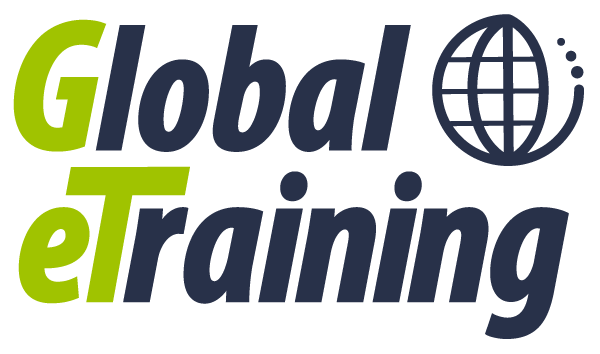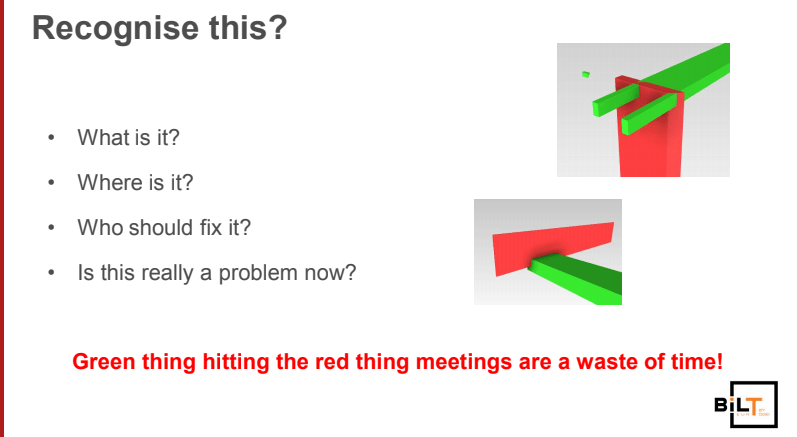This post was created by Newforma Konekt and originally appeared on their blog March 3 2020
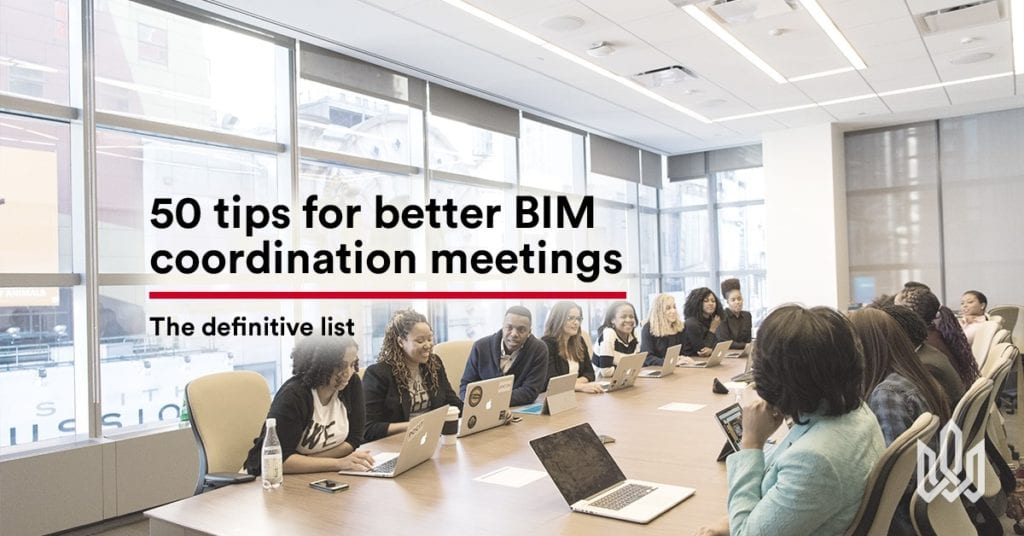
We all love having the latest and greatest tools.
Yet, when it comes to BIM coordination meetings, we consistently hear from our clients that getting buy-in from teams remains the biggest challenge.
The reality is, without buy-in and engagement, the best tech in the world is a moot point. You can’t beat the basics of good ol’ people management.
 The best coordination meetings strike a winning balance of both aspects. We tip our Newforma Konekt hats to those of you in the thick of it, running coordination meetings every week. And we want to help you!
The best coordination meetings strike a winning balance of both aspects. We tip our Newforma Konekt hats to those of you in the thick of it, running coordination meetings every week. And we want to help you!
We picked a few bright industry brains to give you a treasure trove of tips, tricks, and anecdotes that touch on every aspect of your BIM coordination meetings. You might be using some of these already, but who knows? Maybe you’ll pick up something new that you can try in your next coordination meeting.
Here’s a quick overview from one of our newest #BIMTrackers, Louisa Fletcher:
We’ll cover what you can do before, during, and after your meetings to set yourself up for success, as well as how to get buy-in from the right people, maximize your coordination tech, and even how to (gasp!) make meetings fun!
Coordination kickoff ⚽
There’s nothing quite like the start of a new project. The coordination phase is beginning, and you’re ready for your kick-off meeting! Here are our tips to help you get things started.
- Get the right person in the driver’s seat. If you’re running the meetings, take a long look in the mirror. You need someone who has the necessary technical knowledge to understand the issues and their assignation. You also need someone who can manage a meeting and isn’t afraid to hold people accountable. If you don’t have one person who is a good fit, Alice Leung, Investment Associate at Brick and Mortar Ventures (and formerly BIM Manager at DPR Construction), suggests pairing up a technical expert and a project manager for a dynamic duo.
- Kick-off the BIM coordination process with an in-person, relaxed, and sociable meeting. Think of it as a time for team building. After all, you’re going to be seeing each other week in, week out, so it’s time well invested in building rapport and a team mindset. Just this once, let people take the floor, introduce themselves and get comfortable.
- Discuss your BIM Execution Plan, and lay some ground rules so that expectations are clear. When you communicate expectations clearly from the start, you can hold people accountable throughout the coordination process.
- Review the coordination schedule and get buy-in. In a lean coordination process, the BIM coordination schedule is related very closely to construction, so keeping on top of your construction planning and schedule is especially important.
- Make time for software walkthroughs. A strong recommendation from our experts is to give an introduction to the technology your team will be using throughout the coordination process. Michael Boyd, Head of Digital Services at WSP in the UK, recommends giving a half-hour overview of how Newforma Konekt works, and how you’d like your team to use it on the project, paying special attention to the communication workflow chosen by your team.
It’s all in the preparation
Proper preparation is a no-brainer for any productive meeting. While everyone’s formula varies, there are some basics you should be sure to cover. Roll up your sleeves and read on to find out more:
- Notify your teams of when you will be running clash detection. Running clash detection at the same time and day of the week means people know what to expect and can make sure they get their models cleaned up in advance.
- Never give Friday as the deadline for uploading models, ‘cause it always turns into Monday morning, shares Darren Roos, BIM Director at Bernards. #Relatable ?
- Assign issues automatically to each team. Jacob D’Albora, Director of BIM-FM Services at McVeigh & Mangum Engineering takes their coordination matrix one step further, by assigning issues in bulk to different trades. For example, all structural vs MEP clashes would be auto-assigned to the MEP team because the MEP team needs to go through those clashes regardless. If they find something in their issues that isn’t really theirs, they will reassign it to the relevant team on-the-fly. Newforma Konekt gives full visibility of the issue history to ensure this process isn’t a free-for-all!
- Decide your agenda formula and repeat – whatever that looks like.
- Many we spoke to have the BIM coordinating team set the agenda initially by setting a status “to be reviewed” in Newforma Konekt and filtering from there. The coordination lead then triages the list based on which issues are more critical in their opinion.
- Darren bases his weekly BIM coordination meeting agenda on no more than 40 new, unassigned issues, usually based on criticality and zone. He labels them in Newforma Konekt with the meeting name and runs the meeting from Newforma Konekt.
- Save the meeting time for issues that need whole team input. Jacob shares that his team sometimes only goes through 10 clashes in a meeting. Most of the time, clashes should be resolvable without needing much discussion – as long as there are rules in place.
- Quick-start your issue list. However you decide to organize your agenda, get your filters set up in Newforma Konekt to address the issues in priority order. If it’s your first time using Newforma Konekt to run coordination meetings, Newforma Konekt’s customer success manager Matthew Londei has a quick-start tip for you. In Newforma Konekt’s issues page, simply filter critical issues by “ascending” due dates and your issue list will be sorted by deadline from overdue to less urgent due dates. Pick the top 40 and away you go!
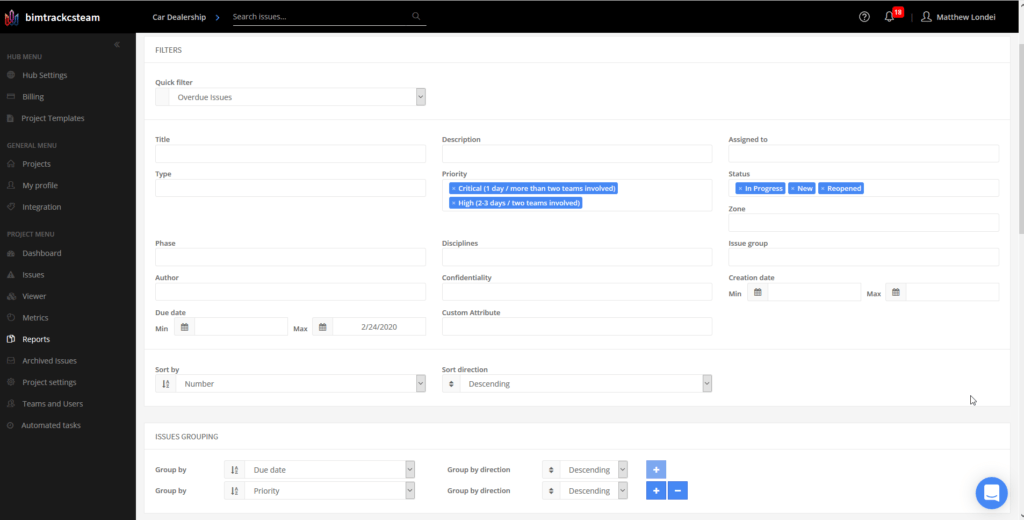
Figure 1.0 Creating a quick start issue list in Newforma Konekt’s web platform.
- Address issues by their relevance to the overall program. This tip takes us back to basics – deciding which issues to address depends on the coordination phase. For example, in the design phase, you are looking at big picture issues, so these types of issues should be assigned top priority. However, in the construction phase, you are looking at more mechanical and electrical issues, so these should be assigned “critical” status. If you’re already doing this, rock on! ?
- Create a coordination report of issues that will be discussed in the meeting, and send it out to the team in advance of the meeting. Ryan Camer, Director of Virtual Construction at Haskell recommends in his webinar that you give people enough time to skim through the report and prepare their thoughts. It’ll make for shorter meetings when people arrive ready!
Now that you are up and running, you’re ready to level-up to our in-meeting tips. Buckle up, we’re on a roll…
How to get buy-in
This is the hardest part of coordination meetings. You know how it is.
People have jam-packed schedules and don’t want to attend yet another meeting. How do you get people excited to be in the room?! Yes, this is possible, according to Michael. Here are our tips to get people on board with the BIM coordination process from the start of your meetings:
- Know who’s in the room. More importantly, know what their motivations and concerns are, and try to alleviate them before they even get in the room. Michael advises that mechanical and electrical engineers are often concerned about their workload expanding beyond their initial commitment – so in their case, you would need to communicate clear limitations on their involvement. Or, people might be worried about their models being forensically examined in a collaborative BIM environment. You can alleviate their concerns by clarifying precisely what you will be looking at and when.
- Get the owner on board with the whole BIM coordination process. If you can win the owner over, then by virtue of their influence, you can win the trust of the other stakeholders too. Go straight for the top! ☝️
- Set clear boundaries and expectations. It’s only fair that people know what they’re getting into. Coordination suffers from a bit of a bad rap where people have experienced the process being drawn out unnecessarily. Clear boundaries around peoples’ work help to alleviate some of the mistrust and fear around ever-expanding hours and insufficient budget to cover them.
- Communicate timing clearly, and stick to it. ⏱️ Whatever you tell the team regarding the meeting’s timing, follow through on it every week. It’ll make it easier for people with busy schedules to commit consistently, and build trust among your team. One hour meeting calendar invite = 1 hour meeting or less IRL.
- Make meetings fun! Rumour has it Darren’s on-site coordination meetings featured a catwalk for the lucky “supermodels” who resolved over 70% of their clashes to strut their stuff down (get it…cause their models were…super!). Take a leaf from his book – fun might just be the missing ingredient you need to make your coordination meetings high-energy and enjoyable. For more inspiration on how to gamify BIM implementation specifically with subcontractors, check out Darren’s Candy Bar Technique.
Best practices during coordination meetings
We heard varied responses on the topic of what you should actually aim to accomplish in your coordination meetings, so you’ll see a variety of perspectives here.
- Respect the learning curve. Michael suggests that in your first coordination meeting you should aim to get through 20 issues at most, in less than an hour. For a team getting used to a new tech stack and processes, this is what they are likely to be able to go away and successfully assign or resolve. You can gradually increase the number of issues over the following weeks.
- Get the right people in the room. In the design stages, you should have the main 3 disciplines around the table, while in the construction phase, you need the lead designer (usually the architect) in the room, and the specialist subcontractors where relevant. Alice recommends always inviting the overall PM, the PM for each participating organization, the BIM/VDC Lead for each organization, and the “hands-on” team of BIM Personnel. Whoever you choose to involve, keep it consistent for that phase.
- Try to have as many people with on-site experience involved as possible. Easier said than done, but we all know it helps. They will be able to check whether what you are doing in the model is actually actionable. Our parent consulting company BIM One recommends that the Coordination Lead on a team should always have on-field construction experience.
- Keep reviewing the coordination schedule. Check in with interim deadlines and remind people what the next week or two looks like. The week-to-week workflow is just as important as the big picture.
- Also on a scheduling note, don’t forget to discuss schedule issues. Alice makes the point that discussing schedule issues is a critical part of coordination meetings. For example, if you have to wait for owner-provided equipment, is it worth coordinating the area at that time, or coming back to it? Keep an eye on the bigger picture.
- Start looking at the issues on a positive note. Make something positive up if you need to, shares Michael (half-jokingly). As cheesy as it sounds, you’ll find that people contribute and collaborate more effectively when coordination meetings celebrate progress as well as address problems. Darren also shared that coordination reports can be a great opportunity to track and call out people’s wins.
- Address high-priority issues, but not exclusively. Yes, it’s important to take care of your critical priority issues. However, if you only address these, you will end up discussing the same issues week after week. Thanks to Michael for that one!
- Issue and assign action items live during meetings so that it’s crystal-clear who is responsible. Strike while the iron is hot, and encourage team members to take responsibility for issues on the spot. Even if you have to referee an awkward game of “issue hot potato” when you ask the all-too-familiar question “Who is going to move?” and are met with radio silence. Darren uses a cricket noise on his computer when this happens to lighten the tension and get someone to speak!
- Ask people to set their own deadlines when assigning issues live. All interviewees agreed that getting people to say when they will resolve issues was more effective than telling them. It’s much easier to hold someone accountable to their own deadline! Ideally, you’re also assigning issues in Newforma Konekt during the meeting so they can be resolved directly in the model as soon as team members return to their desks.
- Practice camaraderie: Alice says to be fair with one another when assigning issues for resolution. Maybe if one time the plumber moves a pipe, next time an electrical engineer can be the one to move. Spread out the load (within reason) and make sure you’re not always asking the same team to make accommodations.
- Are you going to resolve your critical issues on-time? Use Newforma Konekt’s metrics dashboard to break down overall progress and how many issues are left in certain areas live in the meeting. Owners are particularly invested in increasing efficiencies, so this may be a way to pique their attention.
- Word of warning: use metrics wisely. Having just said that you can break down exactly who is responsible for issues and resolution progress using Newforma Konekt, it’s not always a good idea to flash these metrics publically. Michael recommends using discretion to decide when it is appropriate to share this level of visibility with the whole team, depending on how much carrot or stick you want to use.
- Pay attention to what is and isn’t working. Keep note of what does not work well in your meetings and reiterate for improvement. Change it up until you find something that works!
- Address individual issues privately. Talk to anyone who is lagging behind or lacking enthusiasm 1-1 rather than publicly shaming them. People like to hide behind computers, but construction is very much still a relationship-based industry, and touches like these can make a big difference. Try making a call or talking to someone in person for a change (feels radical these days!).
- Follow up with as-needed meetings to address issues that only involve a couple of disciplines. For example, Michael shares that this might mean that in the construction phase, you have more M&E meetings than general coordination meetings.
Prioritize ruthlessly
Meetings always running over? As you can see from the section above, there is a lot to think about and get through in one meeting! Here are our tips for making sure you save time for what’s most important.
- Limit the number of participants. Yes, not everyone gets invited to the party. It may seem mean, but limiting the number of participants in a meeting can make sure everyone is actively engaged, which makes for a more productive meeting. One of Darren’s colleagues from Turner Construction has a simple rule of thumb which we THINK originally came from Jeff Bezos, CEO of Amazon: don’t have a meeting with more people than you can feed with two pizzas. ??
- Limit the meeting time. Some of our interviewees never let meetings go over an hour. Others were a little more relaxed, allowing 1.5 to a maximum of 2 hours. The common thread was that shorter meetings keep everyone fresh, focused, and not wondering about their inbox / next snack break.
- Don’t try to resolve issues during the meeting – except in the rare cases where you really need the whole team’s input. Your time is better spent deciding whose responsibility it is to resolve issues and taking care of assignation.
- Plan your order of attack. Is there someone in the room with just a few specific issues they need to give input on? Michael suggests triaging issues based on who’s involved and letting team members leave early if they are not needed. Making the extra effort to respect people’s schedules always pays off.
- Create a shortlist of the top 10 issues that you know you have to address. Start with these high-priority issues, and then you’ll know that if you get to nothing else, at least you covered what was most important. This makes it much easier to finish meetings on time.
Use technology to your advantage
If you think you can run a coordination meeting by just going through a long list of clashes, think again. Carl Storms sympathizes: it can be easy to spend most of the meeting coordinating the meeting, especially without a tool like Newforma Konekt. You need something to steer you through that jungle.

Thankfully, there are plenty of tools at your disposal. Here are our techy tips and tricks, to make your tech work for you.
- Find a dedicated space (aka #BIMCave) that is well-equipped for your needs. Make sure you, the person running the BIM coordination meeting, have a fast computer to avoid delays and losing peoples’ attention while processing models. It’s probably obvious but bears repeating: make sure you have a large screen(s) or projection with good visibility for all team members in the room.
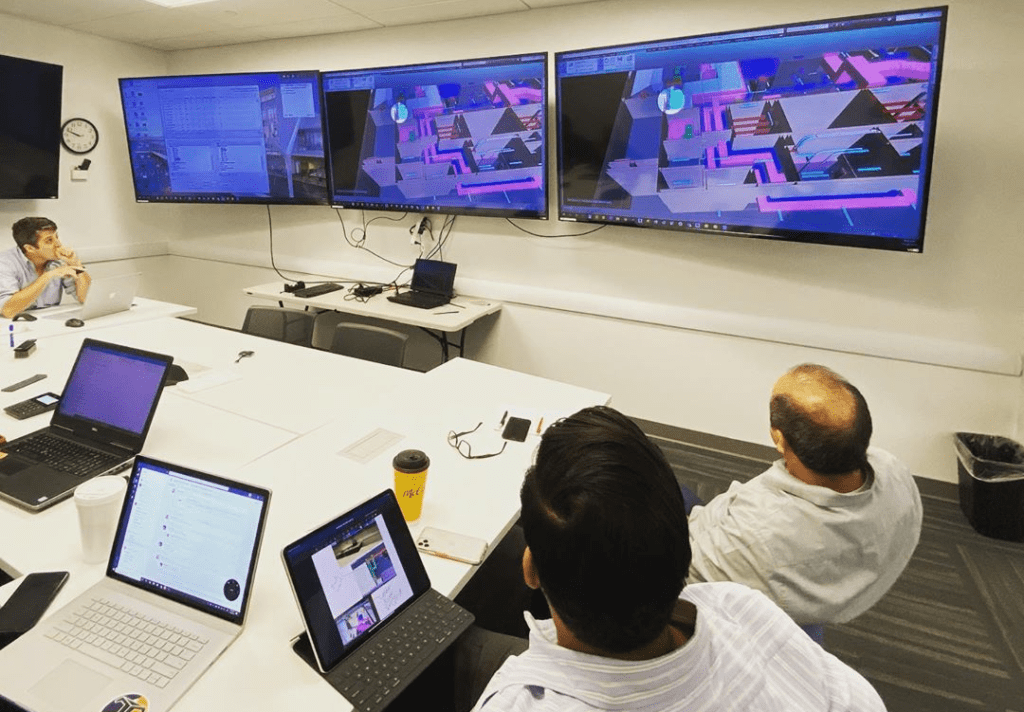
Figure 2.0 An awesome #BIMCave from the team at Titan AEC using Logitech presenter to focus on clashes during BIM coordination with design team and trade contractors using BIM 360 and Newforma Konekt.
- Schedule coordination reports to run and get sent out automatically in advance of the meeting. Keep your timing consistent for running coordination reports so your team knows what to expect. You can also issue them afterwards to keep track of what was discussed in-meeting.
- Ask people to bring their laptops so they can view, comment on, and assign issues live in Newforma Konekt during the meeting. Instead of depending on the BIM coordinator to note everything, get everyone involved and taking responsibility by having them all following along and even changing issue status /assignation in Newforma Konekt’s web platform during the meeting. You’ll probably still get some teams coming in with paper plans too, and that’s ok. The important thing is that they’re part of the process.
- Use section boxes to provide context around issues. Seeing clashes with no context is a waste of everyone’s time. In fact, Michael shared a pretty ruthless rule of thumb in his presentation at BILT Europe 2019: “if you ever see a green thing hitting a red thing in a coordination meeting, walk out.” Check out our blog post to learn more about mastering views in Revit.

Figure 3.0 The pointlessness of looking at Navisworks clashes alone: green thingy vs red thingy meetings.
- Use Newforma Konekt’s quick filters to save time. Most people filter issues by discipline. Ready for a revelation? Michael explains how to use quick filters to target issues more precisely. He suggests filtering by specific groups of people to reduce the amount of “noise” people receive with assignations and notifications.
- Group issues by your own notion of criticality. For example, Michael’s team created custom criticality fields for design phase coordination, a “critical” issue could be a design issue that is urgent. A “high” issue could be a design issue that is not urgent, and a “moderate” issue could be something like a simple misalignment.
- Hack Newforma Konekt’s status fields to get everyone involved in creating the agenda. Jacob shared with us how his team uses custom status fields to allow the whole team to add to the agenda throughout the week. Team members can change an issue status to “team meeting” to flag an issue for whole team input, and then all that’s required before the meeting is to schedule a coordination report to be sent with all issues marked “team meeting” for an instant agenda. Filter via that status in your meetings as well to run your meetings live in Newforma Konekt. ?
- Don’t be afraid to try remote meetings if you’re not already. Remote coordination meetings can definitely work, and you’ll probably have to involve team members remotely at some point in the coordination process anyway. Darren recommends asking questions to make sure people are listening and always using video to keep engagement levels up. Keep the screen moving too!
- If you’re using Newforma Konekt’s viewer, schedule and automate model uploads before meetings. Save time by automating the process of uploading models to the Newforma Konekt IFC viewer at a convenient time in advance of your meetings. No need to chase people to upload their models!
The perfect project ?
We get that it’s not always possible to run things exactly how you would like on every project… But in an ideal world, here are some ways you can save yourself some heartache by setting things up perfectly in the first place:
- Work to reach contract consensus with stakeholders. Alice emphasizes the importance of getting stakeholders from the client’s side, designers, and key contractors to agree on a baseline of how and where they will implement BIM. This will help to get sufficient staff, budget, and resources assigned to the project from the start. Ideally, you should get this commitment written into the contract before you even begin coordination.
- Define your BIM Execution Plan clearly. ? A lot of problems can arise when you don’t establish the BIM Execution plan early, and people end up taking on more responsibility than they signed up for. Define the level of commitment clearly, and think logically and reasonably about how much it costs to implement BIM at the committed level. Check out BIM One’s blog post for more on how to create a killer BEP!
- Get people involved in establishing the BIM Execution Plan together. Now, we know this won’t work for every project, but it would be cool if it could! Darren shared how he got project teams invested in the BIM Execution Plan. He sets up paper boards around the meeting room, each with a general topic (eg. ”file-naming conventions”) on it as well as the template information under each topic (eg. “all file names should include the building name and level”) Team members could then go around with green and red stickers to indicate if they agree with the statement or not, and use markers to add their comments. They would then discuss and collate a mutually agreed-upon BIM Execution Plan.
- Ideally, preparation begins before the design stage. Taking the time to do pre-modeling spatial planning will ensure a strong start to the coordination process.
Congratulations! You made it through all 50 nuggets of wisdom and are officially a BIM coordination meeting Jedi.
We’d like to issue a big thank you to #BIMTrackers Ryan Camer, Alice Leung, Darren Roos, Jacob D’Albora, and Michael Boyd for their time and insights. We could talk coordination all day long…
If you’ve never used Newforma Konekt in your coordination meetings, book a one-on-one demo with us to find out how your next project can run more smoothly!
